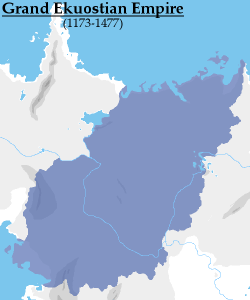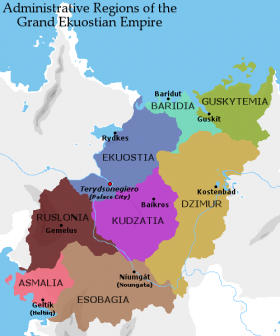Grand Ekuostian Empire
| Grand Ekuostian Empire | ||||||
| Ekuostasudsímb | ||||||
| ||||||
| ||||||
The max extent of the GEE, in 1250.
| ||||||
A map showing the administrative regions of the GEE whilst at its height.
| ||||||
| Capital | Palace City | |||||
| Languages | Middle Ekuostian, Old Dzimraic, Azri, Karmaian, High Lonish, Aysmai | |||||
| Religion | Orthodox Iovism | |||||
| Government | Absolute Monarchy | |||||
| Grand Emperor | ||||||
| • | 1173-1242 | Ástlem Yobátmás | ||||
| • | 1242-1284 | Otímsu I | ||||
| • | 1284-1326 | Koruos | ||||
| • | 1326-1375 | Otímsu II | ||||
| • | 1375-1411 | Gerut III the Brave | ||||
| • | 1411-1459 | Norusaít II | ||||
| • | 1459-1477 | Mástát | ||||
| Historical era | Middle Ages | |||||
| • | Proclaimed | 23 March 1173 | ||||
| • | Collapsed | 19 September 1477 | ||||
The Grand Ekuostian Empire (Ekuostian: ekuostasudsiòmb, IPA: /ekwʌst̪ɑs̪ud̪s̪y:mb/) was a large empire in Ekuosia that flourished during the Middle Ages. It was proclaimed in 1173 by King Ástlem Yobátmás of the former Kingdom of Ekuostia, who then became immortalized as Ekuostia's yomtasudsí (founding ruler). The empire was proclaimed and grew at an alarming rate in the name of Iovism, namely trying to stamp out the Adzamasiin religion which remained ever popular in the region even centuries after the collapse of the Adzamasi Empire. After Ástlem's death in 1242, however, the empire began a slow and steady decline until eventually, by 1477, all it had left was Ekuostia and Baridia.
Etymology
The empire's name of course comes directly from "Ekuostia", which is a historical subregion (of the larger region of Ekuosia) that the Ekuostians dominated thousands of years ago. The subregion was named as such after the Ekuost dynasty, the third of the "Ten Dynasties" of Palace City and the first to have actual historical evidence as to their existence.
History
Before the Rise
The GEE was preceded by a centuries-spanning era of extreme political and religious imbalance, in which the majority of Ekuosia was divided into numerous small realms wrought with interdynastic warfare and general conflict, largely a result of the collapse of both the Letsatian Empire and the Adzamasi Empire centuries prior. While most of Ekuosia was scrambling to stay organized enough to simply maintain order, both Ekuostia and Halaria were doing rather well, all things considered. A change in rule within Ekuostia in 1006 from the small and more economically-minded Íkoímbet dynasty to the Yobátmás dynasty led to a change in priorities. Being an established and accomplished religious dynasty hailing from vassal bishoprics in Tolbayad, the Yobátmás dynasty obviously had plans to spread their faith.
So in 1011, 5 years into his reign, King Gerut II effectively declared war on all belief systems that were not Iovist, and even had laws put into place that encouraged adherents of non-Orthodox branches of the religion to adhere to what he felt was the purer form of the faith. However, the king did not accomplish much in the way of conquest. Gerut's daughter, Norusaít, inherited the throne upon his death in 1034, and almost immediately began to betrothe and/or marry her children to smaller theocratic nobles ruling land in the Ekuostian hinterlands, which at the time were largely lorded over by Halaria. She also began to make small land gains towards Kudzatia and Lons. After she died in 1082, her eighth child, Kusyet, ascended to the throne at the age of 12 and ruled for 71 years. During her reign, several of the marriages Norusaít arranged came to fruition, and vast swathes of land came into vassalage under Palace City as her dynasty began to spread its influence.
Kusyet is known for having outlived all six of her children, leaving the throne to be inherited by one of her grandchildren; the electors, in a plot to aggrandize their own dynasties' influence, chose to crown her youngest grandson, Ástlem, in 1153 following her death. Upon accession Ástlem was only 2 years old, and many of his early councilors were known to abuse their positions in the wake of the young king. However, his primary guardian, Gálas (who was, being Kusyet's oldest grandchild, also his cousin), was a very capable political figure and was able to minimize the damage to Ástlem's credibility caused by his councilors' abuses. She was also quite effective at grooming the young king to grow into a formidable ruler, as shown in his earliest conquests beginning in 1166, when he was 15.
Ástlem's Reign
In 1173, at the age of 22, Ástlem proclaimed his kingdom an empire after numerous successful campaigns in what were denoted "heathen" lands in the chronicles of the time. One of the earliest areas Ástlem conquered following the proclamation of the empire was Kostenbad.



